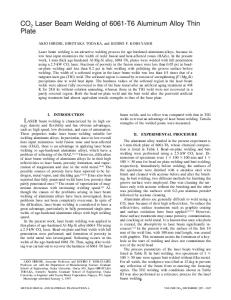Numerical Investigation of Residual Stress in Thick Titanium Alloy Plate Joined with Electron Beam Welding
- PDF / 1,004,141 Bytes
- 10 Pages / 593.972 x 792 pts Page_size
- 37 Downloads / 433 Views
ODUCTION
ELECTRON beam welding (EBW) is a popular manufacturing process for joining very thick components in the automobile, aerospace, construction, and power-generation industries. Compared with conventional welding processes, EBW efficiently offers welds with high depth-to-width ratio, narrow fusion zone, and heat-affected zone (HAZ). In particular, the high vacuum in which the EBW typically is performed avoids material contamination and yields deep penetration. However, as a fusion welding process, residual stresses definitely are generated in the joints with EBW. The experimental results on EBW of a highstrength nickel-based superalloy by Stone et al.[1] indicated that the 1000 MPa longitudinal tensile stress appeared near the center of the weld and decreased quickly to compressive stress at the 7-mm location from the weld centerline. Their investigations demonstrated that the welding residual stress gradient in the joints of EBW is great. The steeper stress gradient within the narrow weld may influence the mechanical behavior of the welded joint greatly, and such effects must be accounted for in any estimate of the useful working life of the component. Thus, it is important that this behavior is acknowledged and quantified. Measurement of residual stresses within the very thick welded components with EBW is very difficult, CHUAN LIU, Postdoctor, and JIAN XUN ZHANG, Professor, are with State Key Laboratory for Mechanical Behavior of Materials, Xi’an Jiaotong University, Xi’an, 710049, P.R. China. Contact e-mail: [email protected] BING WU, Doctoral Student, is with State Key Laboratory for Mechanical Behavior of Materials, Xi’an Jiaotong University, and with the National Key Laboratory of High Energy Density Beam Processing Technology, Beijing Aeronautical Manufacturing Technology Research Institute, Beijing, 100024, P.R. China. Manuscript submitted January 23, 2010. Article published online July 22 2010. METALLURGICAL AND MATERIALS TRANSACTIONS B
especially for internal stress measurement. The X-ray method only can be used to measure the surface stress.[2,3] Neutron diffraction can determine the full residual stress below the surface, but it is expensive and limited by the complexity, size, and weight of the component that can be investigated.[4] The internal stress induced by EBW can be measured with the T-edge and lZ-method,[5] but the components must be destroyed fully. The deep hole drilling (DHD) method can measure the internal residual stress in thick-section welds[4,6]; however, with the DHD method, a 20-mm diameter core must be trepanned from the test piece, and the core size is probably larger than the fusion zone of an EBW joint. So, the DHD method may be unavailable for the internal stress measurement of electron beam (EB) welds. With the development of modern computer and computing technologies, the finite element method (FEM) has been developed as a very important tool to investigate the welding process. Researchers have integrated the FEM with the surface residual stress measurement to investigate the s
Data Loading...











